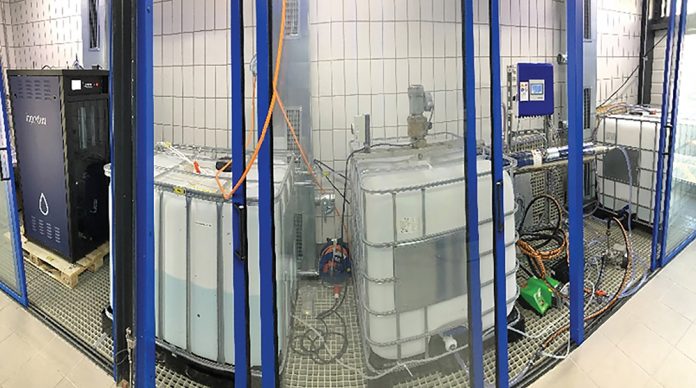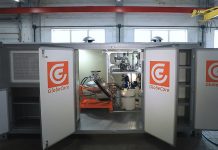A collaboration between HPNow, Evonik and Xylem is showing how sustainable treatment processes can turn wastewater into healthy drinking supplies.
Strong population growth, contamination from industrial and municipal uses, and critical regional droughts are placing great stress and challenges on global water resources and, consequently, on water purifiers. In addition to decades of proven drinking water treatment processes of surface and ground waters, there is a strong future need to recycle municipal wastewater in order to relieve the growing pressure on water resources.
For this purpose, advanced oxidation processes (AOPs) are an essential part of the treatment chain. AOPs are used to remove harmful trace substances (e.g., 1,4-Dioxane, ibuprofen) that find their way into the water cycle – for example, through the use of hygiene products, medicines, or industrial production – and that would accumulate to critical concentrations in drinking water if not removed. In addition to eliminating micropollutants, established AOPs act as an effective disinfection barrier against viruses, bacteria, and protozoa.
A key component of AOPs is hydrogen peroxide (H2O2). This is converted by ozone or UV light into highly reactive, extremely short-lived hydroxyl radicals, which remove harmful trace substances in an environmentally friendly, economic, and efficient manner.
On-site generation of hydrogen peroxide holds strong benefits to logistical, handling safety, and regulatory challenges and can complement today’s established hydrogen peroxide production and supply chain. Copenhagen-headquartered HPNow has developed and brought to market a technology solution, branded as HPGen, which can make use of low-concentration H2O2. Utilizing proprietary direct electrochemical synthesis, HPGen generates low-concentration H2O2 directly at the point of use, in a secure and sustainable manner.
The collaboration: HPNow, Evonik and Xylem
The innovative approach of this project is to produce hydrogen peroxide directly at the point of use, thus demonstrating the safe and reliable integration of this technology into a typical water treatment scheme using a UV AOP solution.
For this purpose, an HPGen – UV AOP facility was installed in April 2021 at Evonik’s premises in the Industrial Park in Hanau-Wolfgang, Germany. The test plan focused on evaluating the removal efficacy of four emerging contaminants using this unique combination of in-situ H2O2 and UV. HPNow’s HPGen on-site H2O2 generator was integrated with Xylem’s WEDECO low-pressure UV reactor.
HPGen produces hydrogen peroxide using only tap water, electricity, and oxygen from the ambient air. Xylem’s UV reactor “activates” the H2O2 into the desired hydroxyl radicals. Due to the very high reactivity of the hydroxyl radicals with micropollutants and other water constituents, the substances are oxidized within fractions of a second and no hydroxyl radicals remain in the water.
Ibuprofen, caffeine, dichlorobenzamide, and 1,4-Dioxane were spiked to the process water as target pollutants and the degradation behavior was investigated in UV-AOP using the environmentally friendly oxidant H2O2. Within this process, hydrogen peroxide decomposes into oxygen and water only.
The results
Both test series with 5 and 10 mg H2O2/l showed good to very good degradation results of all substances. In both tests, the same pattern was revealed with the strongest reduction of ibuprofen, followed by caffeine, dichlorobenzamide, and finally, 1,4-Dioxane, with the double H2O2 dose increasing the log reduction by a factor of about 1.4.
Benefits for users
The test results support the treatment processes practiced worldwide with AOP to produce drinking water. 1,4-Dioxane is a particularly resistant micro-pollutant to oxidative wastewater and drinking water treatment processes. Consequently, good 1,4-Dioxane reduction suggests even better reduction of most other micropollutants. By combining HPNow’s decentralized HPGen hydrogen peroxide generators with UV, an advanced and environmentally friendly technology can be implemented while eliminating the need to transport, store, and handle high-concentration peroxide. Of no less importance is the positive impact on sustainability. A substantially reduced carbon footprint is achieved through the combination of highly efficient direct electrochemical generation, as well as the elimination of transportation emissions. In fact, with the use of green electricity, HPGen-UV’s carbon footprint can be reduced to near zero.
This project has successfully demonstrated how combining the expertise, products, and technologies of Xylem, HPNow, and Evonik opens up sustainable opportunities in treatment processes to reuse wastewater for potable purposes and can provide people with healthy drinking water.
HPNow provides hydrogen peroxide generation solutions for clients’ water treatment needs. More details at hpnow.eu
For information on Evonik, visit
active-oxygens.evonik.com/en/markets/environmental-applications
More details about Xylem at
xylem.com/en-us/products-services/treatment-products-systems/disinfection-and-oxidation/advanced-oxidation-processes-aop






